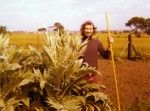Joan Pisanek has been reading her gardening magazines and spotted something that may be of interest to those of you with the dreaded Mare’s Tail.
It is apparently used in vineyards where they cut the tops off, place them in water and then use that water to spray on the vines, as it’s full of silica it creates a waxy coat and protects the fruit from mildew. Maybe not too many vines in Craigentinny but it might be worth trying on plums or gooseberries for example. Good luck to those of you who want to give it a go.
AND……..
For those of you who would rather just get rid of it.
Horse or Mares Tail, Equisetum Arvense is public enemy number one. It looks like it belongs in Jurassic Park and, unchecked, spreads like wildfire.
In spring, brown green shoots appear with small cones at the tips that produce spores. It grows away from creeping thin brown roots that you can hardly see as they are soil coloured. Digging out these roots is not feasible – they go down into the soil for up to 1.5 metres – yes, 5 feet.
Later the ‘leaves’ or tails appear. These will die off as autumn turns to winter and the roots sit there waiting for spring. The leaves have a waxy coat, which makes the plant highly resistant to weedkillers.
Crushing the leaves to break up the coating helps weedkiller to penetrate and become absorbed but in large areas it is not so easy to crush all the leaves . However, glyphosate weed killer will have an effect and eventually kill the plant. You will probably need 5 or more applications. Knock it back, it re-grows and you repeat.
I don’t think you can clear this in less than one season.
Ammonium Sulphamate seems to be a far more effective weed killer. It can kill it in one application but may well need two. It used to be available as Amicide but now you need to look for a brushwood killer that incorporates it like Rootout or Deep Root. Just check the packet for ammonium sulphamate.
I’d recommend NOT digging where there is horsetail until it is dead for sure. Otherwise it just starts springing up from the root cuttings. Drying or drowning the roots prior to composting is a must.
Apparently Horestail is the correct name for the weed growing on land whereas Marestail is correctly applied to the weed growing in water.
Here is an organic control method, which may be effective.
Without resorting to chemicals you can control/irradicate horse tail by digging/forking through the soil when it is in the right condition: ie not too wet and sticky!
Once you have removed as much as possible, any that shoots is easily dealt with. Before it reaches 3 ins/7cm high, hoe off an inch below the surface.
Eventually the food supply in the root is exhausted. Let it get bigger than stated and food begins to be stored in the roots again, and round and round you go ad infinitum.
Never touch Horsetail with a mechanical cultivator. If you do you will understand why it has been around for 60 million years.
AND FINALLY…….
Kibosh kills Mare’s Tail it costs £27.20 per litre and is available from www.progreen.co.uk
